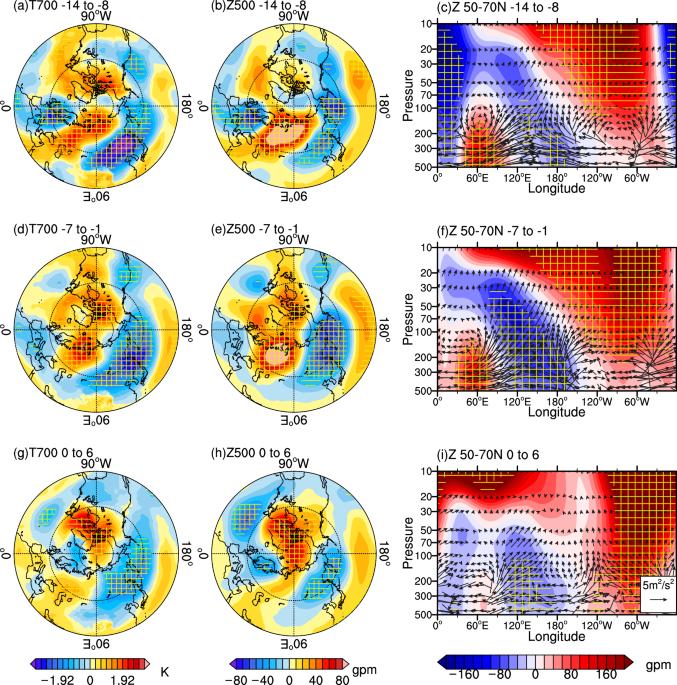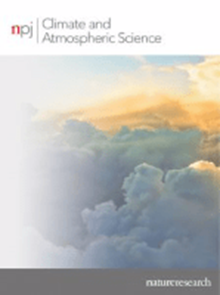平流层突然变暖事件期间伴随着强乌拉尔山脉和弱乌拉尔山脉的不同对流层异常现象
IF 8.5
1区 地球科学
Q1 METEOROLOGY & ATMOSPHERIC SCIENCES
引用次数: 0
摘要
导致平流层骤暖(SSWs)的对流层前兆异常可能会导致不同的环流演变。本研究发现,在乌拉尔脊异常强(SUR-SSWs)和弱(WUR-SSWs)之后的SSWs期间,对流层环流演变存在明显差异。SUR-SSWs在接下来的一周里会出现增强的东亚低谷,而增强的格陵兰脊和对流层环模负异常会持续一个月。相反,WUR-SSW 在欧亚大陆北部表现出地表冷却,但对流层环模异常并不显著。在SUR-SSW期间,增强的乌拉尔波源诱发的波往往在对流层顶以下传播,从而放大了东亚低谷。此外,由于波相速度降低,先前存在的乌拉尔海脊异常向西移动,放大了格陵兰海脊。在 WUR-SSWs 出现之前,东北亚上空原有的降温向西移动,放大了欧亚大陆北部的降温。因此,西南气旋之前的乌拉尔海脊异常会对西南气旋之后的对流层环流产生重大影响。本文章由计算机程序翻译,如有差异,请以英文原文为准。


Distinct tropospheric anomalies during sudden stratospheric warming events accompanied by strong and weak Ural Ridge
Different tropospheric precursor anomalies leading to sudden stratospheric warmings (SSWs) may result in different circulation evolution. This study finds that there are distinct differences in tropospheric circulation evolutions during SSWs following anomalously strong- (SUR-SSWs) and weak- (WUR-SSWs) Ural ridge. SUR-SSWs exhibit enhanced East Asian trough in the following week, while enhanced Greenland ridge and negative tropospheric annular mode anomalies can persist for 1 month. In contrast, WUR-SSWs exhibit surface cooling over northern Eurasia without notable tropospheric annular mode anomalies. During SUR-SSWs, waves induced by the enhanced Ural wave source tend to propagate below the tropopause, amplifying the East Asian trough. Additionally, due to decreased wave phase speed, the preexisting Ural ridge anomalies migrate westward and amplify the Greenland ridge. Before WUR-SSWs, preexisting cooling over Northeast Asia migrates westward and amplifies northern Eurasia cooling. Thus, the Ural ridge anomalies prior to SSWs significantly influence post-SSW tropospheric circulation.
求助全文
通过发布文献求助,成功后即可免费获取论文全文。
去求助
来源期刊

npj Climate and Atmospheric Science
Earth and Planetary Sciences-Atmospheric Science
CiteScore
8.80
自引率
3.30%
发文量
87
审稿时长
21 weeks
期刊介绍:
npj Climate and Atmospheric Science is an open-access journal encompassing the relevant physical, chemical, and biological aspects of atmospheric and climate science. The journal places particular emphasis on regional studies that unveil new insights into specific localities, including examinations of local atmospheric composition, such as aerosols.
The range of topics covered by the journal includes climate dynamics, climate variability, weather and climate prediction, climate change, ocean dynamics, weather extremes, air pollution, atmospheric chemistry (including aerosols), the hydrological cycle, and atmosphere–ocean and atmosphere–land interactions. The journal welcomes studies employing a diverse array of methods, including numerical and statistical modeling, the development and application of in situ observational techniques, remote sensing, and the development or evaluation of new reanalyses.
 求助内容:
求助内容: 应助结果提醒方式:
应助结果提醒方式:


